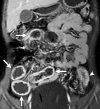Pediatric Small Bowel Crohn Disease: Correlation of US and MR Enterography
- PMID: 25839736
- PMCID: PMC4450979
- DOI: 10.1148/rg.2015140002
Pediatric Small Bowel Crohn Disease: Correlation of US and MR Enterography
Abstract
Small bowel Crohn disease is commonly diagnosed during the pediatric period, and recent investigations show that its incidence is increasing in this age group. Diagnosis and follow-up of this condition are commonly based on a combination of patient history and physical examination, disease activity surveys, laboratory assessment, and endoscopy with biopsy, but imaging also plays a central role. Ultrasonography (US) is an underutilized well-tolerated imaging modality for screening and follow-up of small bowel Crohn disease in children and adolescents. US has numerous advantages over computed tomographic (CT) enterography and magnetic resonance (MR) enterography, including low cost and no required use of oral or intravenous contrast material. US also has the potential to provide images with higher spatial resolution than those obtained at CT enterography and MR enterography, allows faster examination than does MR enterography, does not involve ionizing radiation, and does not require sedation or general anesthesia. US accurately depicts small bowel and mesenteric changes related to pediatric Crohn disease, and US findings show a high correlation with MR imaging findings in this patient population.
(©)RSNA, 2015.
Figures















































Similar articles
-
Detection of Crohn disease lesions of the small and large bowel in pediatric patients: diagnostic value of MR enterography versus reference examinations.AJR Am J Roentgenol. 2014 Nov;203(5):W533-42. doi: 10.2214/AJR.13.11792. AJR Am J Roentgenol. 2014. PMID: 25341168
-
Crohn disease of the small bowel: comparison of CT enterography, MR enterography, and small-bowel follow-through as diagnostic techniques.Radiology. 2009 Jun;251(3):751-61. doi: 10.1148/radiol.2513081184. Epub 2009 Mar 10. Radiology. 2009. PMID: 19276325
-
Prospective cohort study of ultrasound-ultrasound and ultrasound-MR enterography agreement in the evaluation of pediatric small bowel Crohn disease.Pediatr Radiol. 2016 Apr;46(4):490-7. doi: 10.1007/s00247-015-3517-3. Epub 2015 Dec 30. Pediatr Radiol. 2016. PMID: 26718197
-
MR enterography for assessment and management of small bowel Crohn disease.Radiol Clin North Am. 2014 Jul;52(4):799-810. doi: 10.1016/j.rcl.2014.02.001. Epub 2014 Apr 1. Radiol Clin North Am. 2014. PMID: 24889172 Review.
-
MR imaging of the small bowel in Crohn's disease.Eur J Radiol. 2009 Mar;69(3):409-17. doi: 10.1016/j.ejrad.2008.11.013. Epub 2008 Dec 31. Eur J Radiol. 2009. PMID: 19118967 Review.
Cited by
-
CT utilization abruptly increases at age 18 among patients with inflammatory bowel diseases in the hospital.PLoS One. 2018 Mar 29;13(3):e0195022. doi: 10.1371/journal.pone.0195022. eCollection 2018. PLoS One. 2018. PMID: 29596461 Free PMC article.
-
Update on Magnetic Resonance Imaging and Ultrasound Evaluation of Crohn's Disease.Gastroenterol Hepatol (N Y). 2016 Apr;12(4):226-36. Gastroenterol Hepatol (N Y). 2016. PMID: 27231453 Free PMC article.
-
The role of the intestinal ultrasound in Crohn's disease diagnosis and monitoring.J Med Life. 2021 May-Jun;14(3):310-315. doi: 10.25122/jml-2021-0067. J Med Life. 2021. PMID: 34377195 Free PMC article. Review.
-
Ultrasound and MRI predictors of surgical bowel resection in pediatric Crohn disease.Pediatr Radiol. 2017 Jan;47(1):55-64. doi: 10.1007/s00247-016-3704-x. Epub 2016 Sep 29. Pediatr Radiol. 2017. PMID: 27687769
-
Comparison of small intestinal contrast ultrasound with magnetic resonance enterography in pediatric Crohn's disease.JGH Open. 2019 Jul 19;4(2):126-131. doi: 10.1002/jgh3.12228. eCollection 2020 Apr. JGH Open. 2019. PMID: 32280754 Free PMC article.
References
-
- Yu AP, Cabanilla LA, Wu EQ, Mulani PM, Chao J. The costs of Crohn’s disease in the United States and other Western countries: a systematic review. Curr Med Res Opin 2008;24(2):319–328. - PubMed
-
- Benitez JM, Meuwis MA, Reenaers C, Van Kemseke C, Meunier P, Louis E. Role of endoscopy, cross-sectional imaging and biomarkers in Crohn’s disease monitoring. Gut 2013;62(12):1806–1816. - PubMed
-
- Domina JG, Dillman JR, Adler J, et al. . Imaging trends and radiation exposure in pediatric inflammatory bowel disease at an academic children’s hospital. AJR Am J Roentgenol 2013;201(1):W133–W140. - PubMed
Publication types
MeSH terms
Substances
Supplementary concepts
Grants and funding
LinkOut - more resources
Full Text Sources
Other Literature Sources
Medical

